David's Amazing Healing Face
![[The spot in October 2003]](spot1003.jpg) In January of 2004, I went to visit
the dermatologist about a small wound--a tiny little red spot that
occasionally formed a tiny little scab--which I'd had on my face for
the previous eight weeks or so and which didn't seem to be healing.
(Pictured is the spot in October, before it became a little more
evident.)
In January of 2004, I went to visit
the dermatologist about a small wound--a tiny little red spot that
occasionally formed a tiny little scab--which I'd had on my face for
the previous eight weeks or so and which didn't seem to be healing.
(Pictured is the spot in October, before it became a little more
evident.)
Dr. Lee looked at it carefully, and decided that it was probably a
form of sun damage, that it was probably not cancerous, and
that the best thing to do would be to freeze it off and let it heal
naturally.
![[The spot in March 2004]](spot0304.jpg) And that seemed to work. She froze
it with liquid nitrogen, which stung a little but didn't really hurt.
This would eliminate the injury and leave minimal scarring, she said,
assuming it wasn't cancerous. As she predicted, the spot blistered up
for the next couple of days and then healed over the next week, and
then went back to being invisible for a while.
And that seemed to work. She froze
it with liquid nitrogen, which stung a little but didn't really hurt.
This would eliminate the injury and leave minimal scarring, she said,
assuming it wasn't cancerous. As she predicted, the spot blistered up
for the next couple of days and then healed over the next week, and
then went back to being invisible for a while.
![[The spot in August 2004]](spot0804.jpg) Then, after about six months had
passed, the wound reappeared, looking pretty much the same as before.
In August I went back to Dr. Lee, and this time she decided it was
time to to take a biopsy.
Then, after about six months had
passed, the wound reappeared, looking pretty much the same as before.
In August I went back to Dr. Lee, and this time she decided it was
time to to take a biopsy.
A week passed, and the biopsy came back positive; it was cancer
after all. Fortunately, it turned out to be a form of cancer called
basal cell carcinoma, which I'd never heard of; but this is apparently
much better than melanoma, the other kind of skin cancer that
everyone's afraid of. It seems that basal cell cancer generally
doesn't spread to other parts of your body, but just works its way
around under your skin and eats up the skin in that one area.
Dr. Lee scheduled me for Mohs surgery the following Wednesday.
Mohs surgery is an outpatient process in which a small bit of skin is
removed (under local anesthetic), then I am sent to the waiting room
while the doctor examines the skin under a microscope for traces of
cancer. If cancer is found, she calls me back in to remove some more,
and the process repeats until all the traces of cancer are gone.
In my case, we did this four times, and by the end of the process
she'd removed a considerably bigger piece of my face than we'd both
anticipated. Instead of sewing me up with a few stitches, as I'd
expected, she was handing me a plastic surgeon's business card and
telling me that she'd made an appointment for me that afternoon.
Yikes!
The new, open wound was astonishing to me. I couldn't get over how
much it looked like movie makeup; I'd never seen anything like it
anywhere in the real world before, let alone in the mirror. ![[The new, open wound]](heal01.jpg) Now I suddenly had to deal with the prospect of having a
large scar on my face for the rest of my life. It just isn't
something that had occurred to me as a possibility before. Although I
had expected a small scar from the surgery, a large, conspicuous scar
is a completely different thing. And here was this enormous hole in
my cheek, where there would never be healthy skin again.
Now I suddenly had to deal with the prospect of having a
large scar on my face for the rest of my life. It just isn't
something that had occurred to me as a possibility before. Although I
had expected a small scar from the surgery, a large, conspicuous scar
is a completely different thing. And here was this enormous hole in
my cheek, where there would never be healthy skin again.
The plastic surgeon that Dr. Lee had recommended had the improbable
name of Dr. Gross, but he seemed to be a knowledgeable and experienced
surgeon, and his concern for my situation was apparent. However, our
consultation with him wasn't encouraging. Dr. Gross thought the only
realistic prospect would be to apply a skin graft, say from behind my
ear, which would leave a ring-shaped scar on my face. If I were
thirty years older, he said, I'd have enough loose skin that he'd be
able to slide my whole face over to cover the wound and leave very
little noticeable scarring (a prospect which also weirded me out quite
a bit); but since my face fit me pretty well already, he thought that
wasn't a very good option.
I hestitantly asked what would happen if we were to simply let the
wound heal naturally, and the surgeon sadly shook his head and showed
me how he expected that the skin around the wound would pull in to
close it, disfiguring my face by pulling my eye downwards.
But Dr. Gross wasn't able to do any work immediately, since he was
about to go out of town for a week, so he referred me to his superior,
Dr. Sherman, another plastic surgeon who would be available next
week.
Dr. Sherman, as it turned out when we met with him, seemed to have
much better confidence than his coworker in the human body's natural
healing ability. He didn't think the skin graft idea was such a great
one, and thought the slide-the-face-over technique would be my best
bet for minimal scarring. Then he mentioned in passing that I could,
believe it or not, just let the wound heal naturally and it would
close up just fine. I pounced on that suggestion! Really? And it
won't horribly disfigure my face? O.K., let's do that!
![[Wearing the bandage in the
sun]](bandage1.jpg)
![[Wearing the
bandage at night]](bandage2.jpg)
Over the next six weeks, I diligently kept the wound covered with
an antibacterial ointment (Neosporin) and a bandage. And I always
wore a hat when I went out into the sun.
And the wound gradually pulled itself closed, and it didn't pull my
eye down or otherwise distort my face. I took each of the following
pictures on successive weeks. Click on any of them for a close-up
picture.
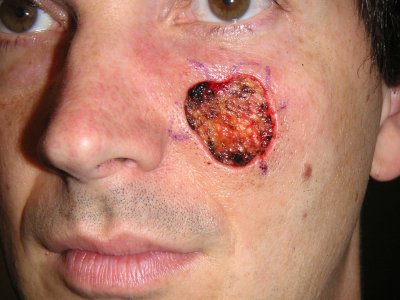
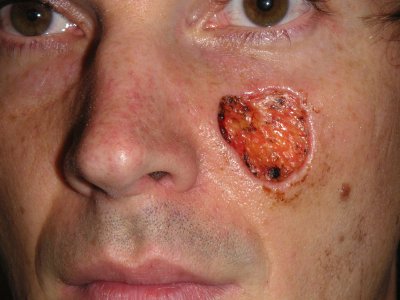
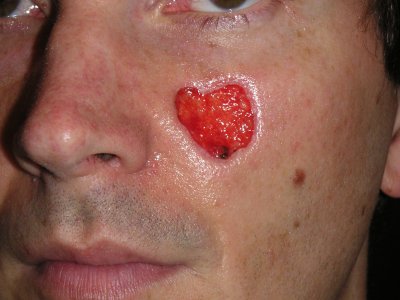
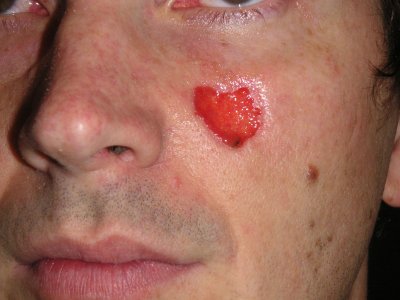
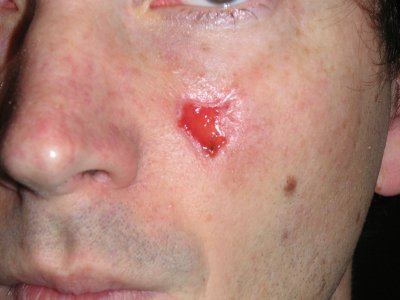
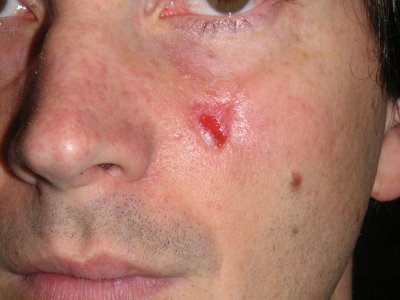
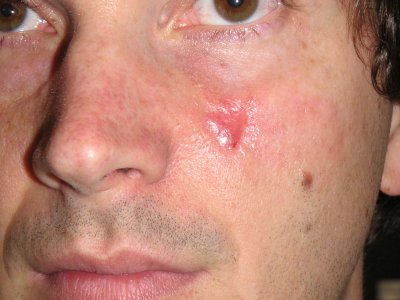
After six weeks had elapsed, I went back for a followup
consultation with Dr. Sherman, who was so surprised and excited to see
how well it had healed that he stepped into the hall to call to
Dr. Gross: "Hey, you've got to come here and take a look at this!"
 Return to scrapbook index
Return to scrapbook index
![[The spot in October 2003]](spot1003.jpg) In January of 2004, I went to visit
the dermatologist about a small wound--a tiny little red spot that
occasionally formed a tiny little scab--which I'd had on my face for
the previous eight weeks or so and which didn't seem to be healing.
(Pictured is the spot in October, before it became a little more
evident.)
In January of 2004, I went to visit
the dermatologist about a small wound--a tiny little red spot that
occasionally formed a tiny little scab--which I'd had on my face for
the previous eight weeks or so and which didn't seem to be healing.
(Pictured is the spot in October, before it became a little more
evident.)![[The spot in March 2004]](spot0304.jpg) And that seemed to work. She froze
it with liquid nitrogen, which stung a little but didn't really hurt.
This would eliminate the injury and leave minimal scarring, she said,
assuming it wasn't cancerous. As she predicted, the spot blistered up
for the next couple of days and then healed over the next week, and
then went back to being invisible for a while.
And that seemed to work. She froze
it with liquid nitrogen, which stung a little but didn't really hurt.
This would eliminate the injury and leave minimal scarring, she said,
assuming it wasn't cancerous. As she predicted, the spot blistered up
for the next couple of days and then healed over the next week, and
then went back to being invisible for a while.![[The spot in August 2004]](spot0804.jpg) Then, after about six months had
passed, the wound reappeared, looking pretty much the same as before.
In August I went back to Dr. Lee, and this time she decided it was
time to to take a biopsy.
Then, after about six months had
passed, the wound reappeared, looking pretty much the same as before.
In August I went back to Dr. Lee, and this time she decided it was
time to to take a biopsy.![[The new, open wound]](heal01.jpg) Now I suddenly had to deal with the prospect of having a
large scar on my face for the rest of my life. It just isn't
something that had occurred to me as a possibility before. Although I
had expected a small scar from the surgery, a large, conspicuous scar
is a completely different thing. And here was this enormous hole in
my cheek, where there would never be healthy skin again.
Now I suddenly had to deal with the prospect of having a
large scar on my face for the rest of my life. It just isn't
something that had occurred to me as a possibility before. Although I
had expected a small scar from the surgery, a large, conspicuous scar
is a completely different thing. And here was this enormous hole in
my cheek, where there would never be healthy skin again.![[Wearing the bandage in the
sun]](bandage1.jpg)
![[Wearing the
bandage at night]](bandage2.jpg)





